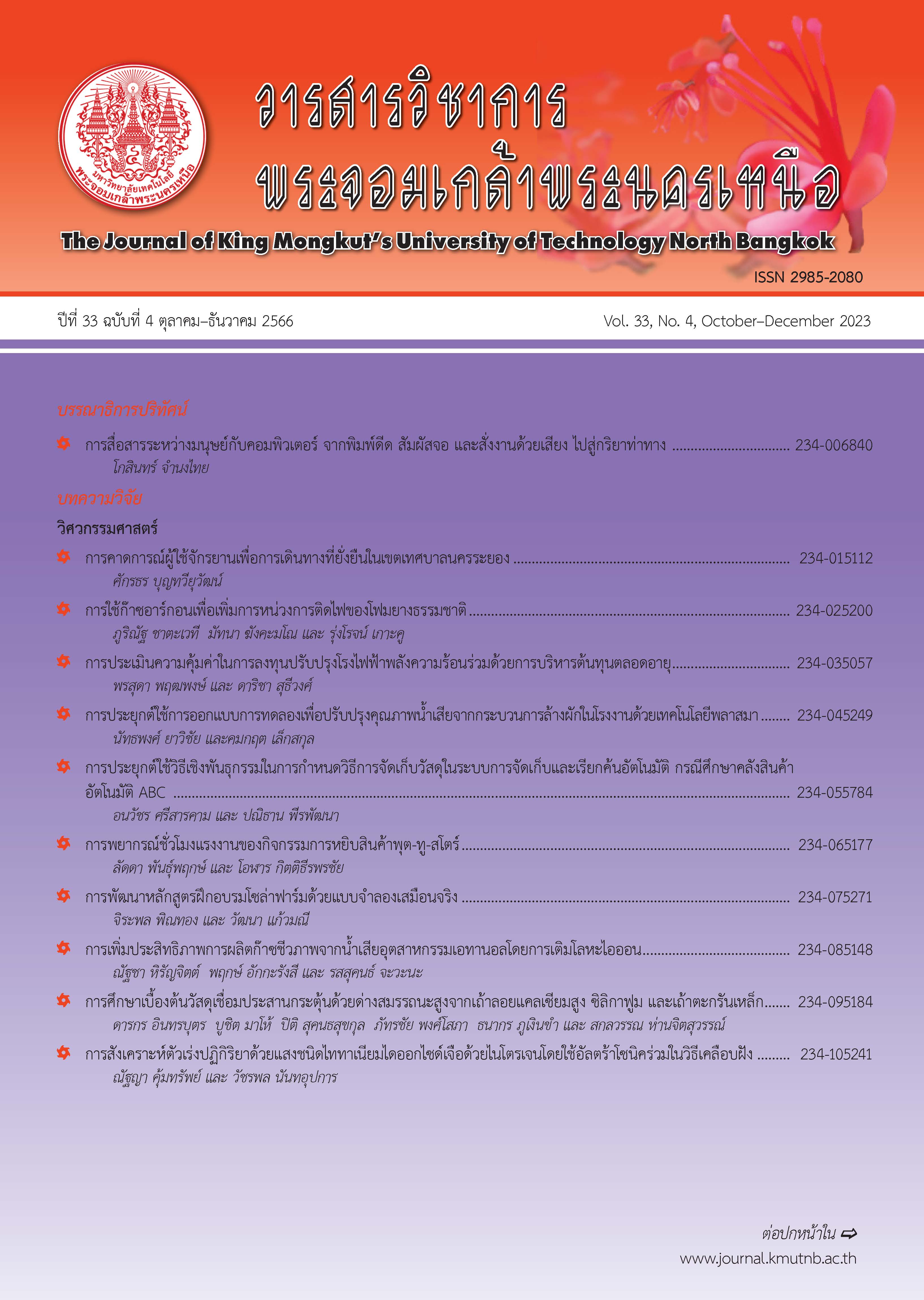การประเมินความคุ้มค่าในการลงทุนปรับปรุงโรงไฟฟ้าพลังความร้อนร่วมด้วยการบริหารต้นทุนตลอดอายุ
Main Article Content
บทคัดย่อ
ปัจจุบันโรงไฟฟ้าในระบบไฟฟ้ามีการเดินเครื่องผลิตพลังงานไฟฟ้าลดลง เนื่องจากการเติบโตและพัฒนาของเทคโนโลยีพลังงานทางเลือก ผู้ประกอบการของโรงไฟฟ้าเดิมในระบบจึงเริ่มให้ความสำคัญกับการตัดสินใจเรื่องการลงทุนปรับปรุงประสิทธิภาพของโรงไฟฟ้า เพื่อคงความสามารถการแข่งขันในธุรกิจ ซึ่งงานวิจัยนี้นำเสนอกรอบความคิดและแบบจำลองการประเมินการลงทุนเพื่อปรับปรุงโรงไฟฟ้า ด้วยหลักการบริหารต้นทุนตลอดอายุ (Life-Cycle Cost Management; LCCM) และนำเสนอการพยากรณ์ปริมาณพลังงานไฟฟ้าที่ผลิตรายปีของโรงไฟฟ้า โดยคำนึงถึงกรอบและข้อจำกัดของโรงไฟฟ้าตามสัญญาซื้อขายไฟฟ้า (Power Purchase Agreement; PPA) สำหรับโรงไฟฟ้าพลังความร้อนร่วมประเภทเพลาผสม (Multi-shaft combined-cycle Power Plant) ทั้งนี้ ตัวแปรที่งานวิจัยเลือกใช้ในการพยากรณ์เป็นตัวแปรที่มีความสัมพันธ์ กับปริมาณพลังงานไฟฟ้าที่ผลิตของโรงไฟฟ้าอย่างมีนัยสำคัญ ได้แก่ 1) ค่าความร้อนของโรงไฟฟ้า (Heat Rate; HR) 2) จำนวนชั่วโมงการเดินเครื่องเสริมระบบ (Service Hour; SH) 3) สัดส่วนกำลังผลิตของผู้ผลิตพลังงานไฟฟ้ารายเล็ก (Small Power Producer Share; SPP Share) และ 4) อัตราการเติบโตของเศรษฐกิจ (Growth Domestic Product; GDP) โดยผลการพยากรณ์ปริมาณพลังงานไฟฟ้าของโรงไฟฟ้าจะถูกนำมาใช้เป็นข้อมูลตั้งต้นสำหรับคำนวณจำนวนชั่วโมงการเดินเครื่องสะสมเทียบเท่าของกังหันก๊าซ (Equivalent Operating Hour; EOH) ซึ่งเป็นปัจจัยที่มีผลต่อการประมาณรายได้และค่าใช้จ่ายในการดำเนินงานของโรงไฟฟ้าและสามารถนำมาใช้พิจารณาเลือกประเภทงานบำรุงรักษาให้สอดคล้องกับรูปแบบการเดินเครื่องของโรงไฟฟ้า โดยผลการประเมินการลงทุนของกรณีศึกษาสรุปได้ว่ากรณีไม่ลงทุนปรับปรุงโรงไฟฟ้ามีอัตราผลตอบแทนภายในของโครงการที่ 8.29% และกรณีลงทุนมีอัตราผลตอบแทน 7.17% ซึ่งน้อยกว่า เนื่องด้วยโรงไฟฟ้ามีเงื่อนไขค่าใช้จ่ายที่แปรผันกับปริมาณพลังงานไฟฟ้าที่ผลิต จึงไม่คุ้มค่าในการดูแลรักษาอุปกรณ์
Article Details

อนุญาตภายใต้เงื่อนไข Creative Commons Attribution-NonCommercial-NoDerivatives 4.0 International License.
บทความที่ลงตีพิมพ์เป็นข้อคิดเห็นของผู้เขียนเท่านั้น
ผู้เขียนจะต้องเป็นผู้รับผิดชอบต่อผลทางกฎหมายใดๆ ที่อาจเกิดขึ้นจากบทความนั้น
เอกสารอ้างอิง
Generation Operation Planning Department, “Yearly Operating Report 2020,” Electricity Generating Authority of Thailand, Thailand, Rep. QWP-PSCOD-19-01-3-02, Dec. 2019. (in Thai)
Energy Policy and Planning Office of Thailand. Electricity Statistic. [Online] (in Thai). Available: http://www.eppo.go.th/index.php/en/enenergystatistics/ electricity-statistic
P.L. Joskow, “Competitive electricity markets and investment in new generating capacity,” AEI-Brookings Joint Center Working Paper, pp. 6–14, 2006.
P. Windrum and C. Birchenhall, “Is product life cycle theory a special case? Dominant designs and the emergence of market niches through coevolutionary-learning,” Structural Change and Economic Dynamics, vol. 9, no. 1, pp. 109–134, 1998.
G. Hu and B. Bidanda, “Modeling sustainable product lifecycle decision support systems,” International Journal of Production Economics, vol. 122, no. 1, pp. 366–375, 2009.
P. Keatley, A. Shibli and N.J. Hewitt, “Estimating power plant start costs in cyclic operation,” Applied Energy, vol. 111, pp. 550–557, 2013
D. G. Dhavale and J. Sarkis, “Stochastic internal rate of return on investments in sustainable assets generating carbon credits,” Computers & Operations Research, vol. 89, pp. 324–336, 2018.
M. N. El-Kordy, M. A. Badr, K. A. Abed and S. M. A. Ibrahim, “Economical evaluation of electricity generation considering externalities,” Renewable Energy, vol. 25, no. 2, pp. 317–328, 2002.
J. S. Adiansyah, M. Rosano, W. Biswas, and N. Haque, “Life cycle cost estimation and environmental valuation of coal mine tailings management,” Journal of Sustainable Mining, vol. 16, pp. 114–125, 2017.
E. Abele, T. Liebeck, and A. Wörn, “Measuring flexibility in investment decisions for manufacturing systems,” CIRP Annauls, vol. 55, no. 1, pp. 433– 436, 2006.
A. Chan, G. Keoleian and E. Gacler, “Evaluation of life-cycle cost analysis practices used by the Michigan Department of Transportation,” Journal of Transportation Engineering, vol. 134, no. 6, pp. 236–245, 2008.
W. Srisuriyajan and C. Thongchaisuratkrul, “The investment and technical analysis of solar power plant development case in Mukdahan province, Thailand”, The Journal of KMUTNB, vol. 30, no. 2, pp. 225–236, 2020 (in Thai).
A. Vazquez and G. Iglesias, “LCOE (levelised cost of energy) mapping: A new geospatial tool for tidal stream energy,” Energy, vol. 91, pp. 192–201, 2015.
Z. Mohamed and P.Bodger, “Forecasting electricity consumption in New Zealand using economic and demographic variables,” Energy, vol. 30, no. 10, pp. 1833–1834, 2005.
F. Egelioglu, A. A. Mohamad, and H. Guven, “Economic variables and electricity consumption in Northern Cyorus,” Energy, vol. 26, no. 4, pp. 355–362, 2001.
R. Aminov and A. Kozhevnikov, “Estimating the influence of intermittent operation on the change of life of a gas turbine,” Electric Power Systems Research, vol. 107, pp. 153–157, 2014.
Thailand Power Development Plan 2018–2037, 1st ed., Energy Policy and Planning Office of Thailand, Thailand, 2019 (in Thai).
R. Koen and J. Hollaway, “Application of multiple regression analysis to forecasting South Africa’s electricity demand,” Journal of Energy in Southern Africa, vol. 25, no. 4, pp. 48–58, 2014.

